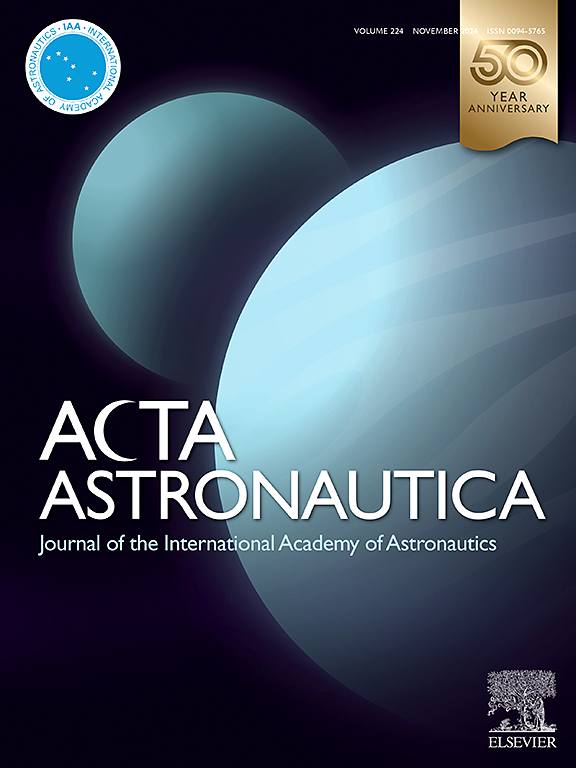Development of small satellite NEXTSat-2 for X-band SAR demonstration
IF 3.1
2区 物理与天体物理
Q1 ENGINEERING, AEROSPACE
引用次数: 0
Abstract
The radar satellites, unlike optical satellites, can acquire the Earth surface images of interest even in clouds or at night; thus, they can be useful for Earth observation under almost all-weather conditions. Recently small satellites have become more attractive even in SAR (Synthetic Aperture Radar) applications due to their low cost of development and enhanced capability. The NEXTSat-2 (Next-Generation Satellite II) is a small radar satellite primarily aimed at demonstrating locally developed SAR technology. it also serves additional purposes, including the verification of core space technologies and the measurement of space radiation. The satellite, having a total mass of 180 kg, was built for X-band SAR with the center frequency of 9.65 GHz and a look angle of 20∼35°. It can produce SAR imagery with the resolution of 5m and the swath of 40 km in StripMap mode. It can provide the power capacity of 36 Ah, the pointing accuracy of 0.04° (3σ), the payload data transmit rate of 320 Mbps, and the data storage of 384 Gbit. The X-band SAR instrument comprises a compact SAR Central Unit, a Power Supply & Distribution Unit, deployable antennas, and Transmit/Receive Modules. The X-band SAR employs a simple and low-cost antenna system while offering large-deployable capability. The antenna is based on the rugged microstrip patch antenna array, which enables low-cost and easy fabrication. This SAR antenna system provides a radiating area of 5.2 m × 0.55 m, consisting of a total of 5 mechanical panels and 14 electrical subarray antennas. The NEXTSat-2 has been operating on a dawn-dusk orbit with 550 km altitude since its launch at Naro Space center, Korea, by the Korea Space Launch Vehicle-II (KSLV-II), in May 2023. Through on-orbit demonstration, the quality parameters of NEXTSat-2 X-band SAR were measured and the pointing calibration was performed to improve the zero-Doppler characteristics. From the SAR images, it is shown that the NEXTSat-2 can provide medium-resolution radar images to meet the needs of identifying and monitoring natural anomalies on a larger scale.
用于x波段SAR演示的小卫星NEXTSat-2的研制
雷达卫星与光学卫星不同,即使在云中或夜间也能获得感兴趣的地球表面图像;因此,它们可以在几乎所有天气条件下用于地球观测。最近,小卫星由于其低开发成本和增强的能力,甚至在SAR(合成孔径雷达)应用中也变得越来越有吸引力。NEXTSat-2(下一代卫星II)是一颗小型雷达卫星,主要用于演示本地开发的SAR技术。它还用于其他目的,包括核查核心空间技术和测量空间辐射。该卫星总质量为180公斤,中心频率为9.65 GHz,观测角度为20 ~ 35°,用于x波段SAR。在StripMap模式下可生成5米分辨率、40公里宽的SAR图像。其功率容量为36 Ah,指向精度为0.04°(3σ),有效载荷数据传输速率为320 Mbps,数据存储容量为384 Gbit。x波段SAR仪器包括一个紧凑的SAR中央单元,一个电源和放大器;分配单元、可展开天线和发射/接收模块。x波段SAR采用简单和低成本的天线系统,同时提供大部署能力。该天线基于坚固的微带贴片天线阵列,这使得低成本和易于制造。该SAR天线系统的辐射面积为5.2 m × 0.55 m,由5个机械面板和14个电子阵天线组成。“NEXTSat-2”于去年5月由韩国空间运载火箭2号(KSLV-II)在罗老宇宙中心发射后,一直在海拔550公里的黎明-黄昏轨道上运行。通过在轨演示,测量了NEXTSat-2 x波段SAR的质量参数,并进行了指向定标,改善了零多普勒特性。从SAR图像来看,NEXTSat-2可以提供中等分辨率的雷达图像,满足更大范围内自然异常识别和监测的需求。
本文章由计算机程序翻译,如有差异,请以英文原文为准。
求助全文
约1分钟内获得全文
求助全文
来源期刊

Acta Astronautica
工程技术-工程:宇航
CiteScore
7.20
自引率
22.90%
发文量
599
审稿时长
53 days
期刊介绍:
Acta Astronautica is sponsored by the International Academy of Astronautics. Content is based on original contributions in all fields of basic, engineering, life and social space sciences and of space technology related to:
The peaceful scientific exploration of space,
Its exploitation for human welfare and progress,
Conception, design, development and operation of space-borne and Earth-based systems,
In addition to regular issues, the journal publishes selected proceedings of the annual International Astronautical Congress (IAC), transactions of the IAA and special issues on topics of current interest, such as microgravity, space station technology, geostationary orbits, and space economics. Other subject areas include satellite technology, space transportation and communications, space energy, power and propulsion, astrodynamics, extraterrestrial intelligence and Earth observations.
 求助内容:
求助内容: 应助结果提醒方式:
应助结果提醒方式:


